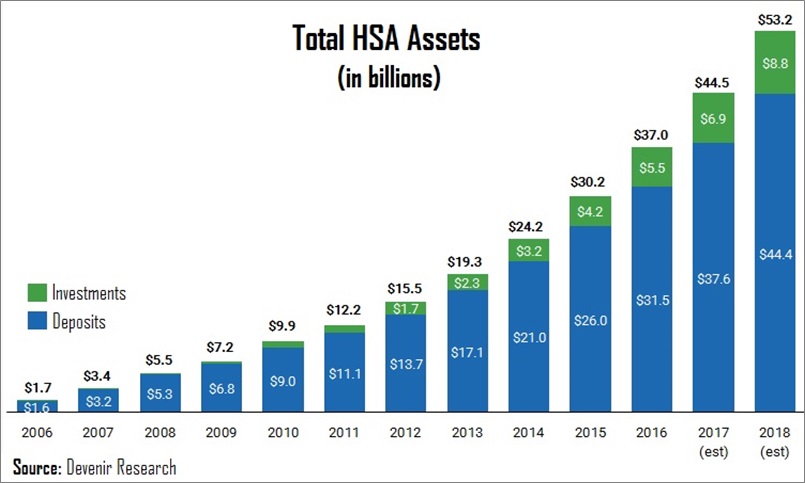While the Republicans’ “repeal and replace” American Health Care Act has been withdrawn for now, apparently left to wither on the vine as Congress attends to other matters, it’s likely that it will be revived in some form or fashion in the near future. If and when the bill does return to the front pages of our favorite newspapers and websites, we can expect to hear again about Health Savings Accounts (HSAs), which seem likely to be a cornerstone of any Obamacare replacement plan.
Unfortunately, HSAs alone are probably incapable of solving our nation’s healthcare woes, for a variety of reasons. That said, just because the accounts won’t be a panacea doesn’t mean that we shouldn’t be paying attention—after all, if properly utilized, they could be the key to a happy retirement for many of us. That’s right, the specific provisions and benefits of HSAs mean that they’re not necessarily limited to being a simple healthcare add-on tool, despite what their name might suggest.
On the contrary, HSAs are potentially more powerful than any IRA, 401(k), 403(b), or other deferred compensation plan could ever be when it comes to saving for retirement. If you’re eligible to contribute to an HSA (or even if you aren’t, but could be), read on to see how you might better utilize HSAs to prepare for multiple financial goals at once.
How do HSAs work?
The first thing to understand is that HSAs, much like Roth IRAs, are not actually available to everyone. In order to be eligible to contribute to an HSA in a given year, an individual must first be enrolled in a qualified high-deductible insurance plan (HDHP, per IRS parlance). Medicare recipients are also not eligible, nor are individuals who are claimed as dependents on anyone else’s tax return, or certain other excluded individuals.
The high-deductible plan is an attractive approach for many people, since the plans typically come with lower monthly premiums. However, the higher deductible can also mean higher overall out-of-pocket costs, which cannot easily be covered by many lower-income individuals. As a result, the benefits of HSAs do tend to be concentrated among wealthier—and healthier—individuals with greater cash flow flexibility.
For those who are eligible, though, an annual contribution of up to $3,400 for an individual (up to a family maximum of $6,750) can be directed to an HSA. Like 401(k) deferrals or traditional IRA contributions, HSA contributions are fully tax-deductible in the year of the contribution (as an above-the-line deduction), allowing for immediate tax relief. Of course, that immediate benefit does carry greater weight for higher-income individuals and families, whose tax rates are highest. It does bear noting, however, that three states (New Jersey, California, and Alabama) do not permit state tax deductions for HSA contributions. In those states, an additional layer of complexity is added, and the decision whether or not to utilize an HSA is less straightforward.
Regardless, the initial tax deduction benefit is far from the only tax-related benefit of HSAs. In fact, HSAs stand alone in that they are “triple tax advantaged”, which is something no other retirement or savings account can claim. In addition to the contribution-year income tax deduction, investment returns earned within HSA accounts are also tax-deferred, again like their retirement plan cousins. However, unlike retirement accounts, withdrawals from HSAs are completely tax-free if used for qualified medical expenses, as defined by the IRS. Therefore, any money directed to an HSA and subsequently used to cover medical expenses will completely avoid taxation, even after investment returns are taken into account.

But what ultimately sets HSAs apart—and what lends them their uniquely flexible nature—is what happens to the funds if they are not needed for medical expenses. For one, HSA funds that are not used in the year of the contribution can be carried forward indefinitely, until they can be used. This is in contrast to their Flexible Spending Account cousins, which are in most cases subject to a “use it or lose it” provision, whereby unspent money disappears and cannot be carried forward.
Furthermore, if funds are held in an HSA until age 65, two additional options become available: remaining HSA funds can be used to cover health insurance (including Medicare) premiums, or they can essentially be treated as IRA funds and used to cover general living expenses. In the latter case, no penalty is owed, and withdrawals incur only ordinary taxes (turning the “triple tax advantage” into a mere “double tax advantage”). In that way, HSAs can be considered something of a hybrid savings vehicle—funds can either be saved for medical expenses or for retirement savings, and only their tax treatment will differ. This contrasts sharply with, for example, 529 plans for college savings, which incur steep penalties if used for any purpose other than college tuition and fees (even secondary school tuition is not a qualifying expense). The hybrid nature of an HSA makes it a particularly attractive savings option for anyone who is eligible to contribute.
To spend or to save?
Once a contribution to an HSA has been made for a given year, savers have three basic options: they can use the funds to cover current-year medical expenses, or they can let funds accumulate and begin earning investment returns as a “rainy day” fund (to cover either an unexpected future medical expense or Medicare/Medigap premiums in retirement), or they can bypass the medical use entirely and simply treat their HSA as an additional retirement savings vehicle, to be used alongside any IRAs or 401(k) plans.
The optimal approach to HSAs (and whether to contribute in the first place) can vary from person to person, depending on health status, general financial condition, risk tolerance, and which other resources and retirement plans are available. Decisions about health care and HSAs should not be made in a vacuum, but must be viewed in a broader financial planning context. At Cypress, we’re always available to help sort through the options and make sense of an increasingly complex healthcare landscape.
